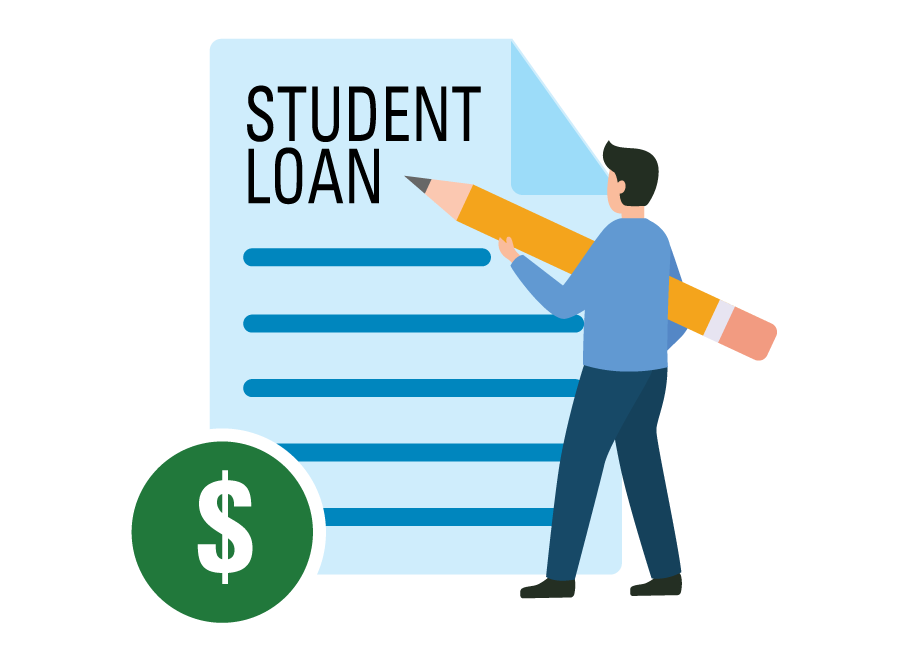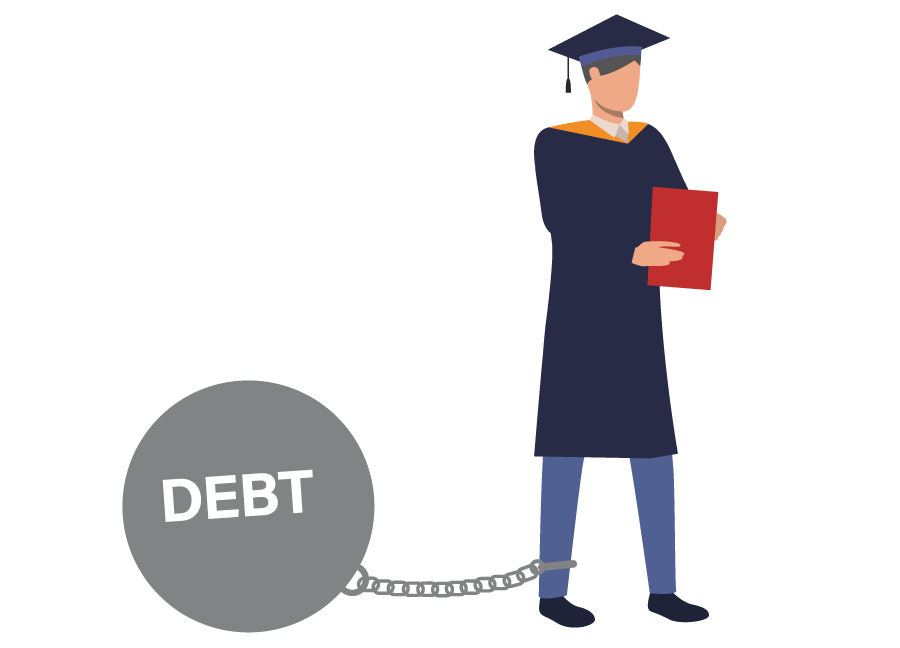Step 1: Get Organized
Staying calm is easier said than done, but it’s an important first step in tackling any amount of student debt. While stress and sleepless nights are common reactions, they rarely lead to progress.
The first practical move is to take stock of all outstanding loans. This means creating a comprehensive list that categorizes each loan as either private or federal, along with the corresponding balances and interest rates.
Federal loans typically come with fixed interest rates that are often lower than those of private loans. Repayment usually begins after graduation, and many federal loans include a grace period. For example, federal subsidized and unsubsidized loans offer a six-month grace period.
While federal loans are generally more favorable due to their lower interest rates and flexible terms, not all students qualify for them. In such cases, private loans—issued by banks, credit unions, state-affiliated organizations, or a combination of these—may be part of the mix. These loans vary widely in terms, interest rates, and grace periods, depending on the lender.
Regardless of the loan type, understanding the full scope of the debt is essential. Without a clear picture of how much is owed and how repayment works, it’s difficult to make informed decisions. Taking the time to organize loan details, including lenders, balances, interest rates, and terms, is a foundational step toward effective debt management.
Step 2: Prioritize Spending
Once the full scope of student debt is understood, the next step is to establish financial priorities. While paying down debt is important, it shouldn’t come at the expense of all other financial goals. Building a modest emergency fund, ideally two to three months’ worth of living expenses, can provide a critical safety net and peace of mind, even while student loans remain outstanding.
From there, the focus can shift to building a sustainable financial routine. Creating a realistic budget is key to balancing debt repayment with other financial needs. This includes allocating funds for savings, essential expenses, and even a reasonable amount for leisure or personal enjoyment. Allowing space for fun can help prevent burnout and ensure that debt doesn’t dominate every aspect of life.
It’s also wise to begin contributing to retirement savings, even in small amounts. If an employer offers a 401(k) plan with a company match, contributing at least enough to receive the full match is a smart move. This match is a meaningful addition to your retirement savings, and when paired with compound interest, early contributions can have a lasting impact.
With a clear understanding of debt and a set of financial priorities in place, borrowers are better-positioned to take meaningful steps toward a student-debt-free future.
Step 3: Accelerate Payments (If Possible)
One of the most straightforward ways to pay off student loans faster is to contribute more than the minimum payment. Even small additional payments toward the principal each month can lead to significant savings over time. For those making only the minimum payments, progress may feel slow and discouraging, despite consistent effort.
However, accelerating payments isn’t always practical. If maintaining an emergency fund or covering basic living expenses is already a challenge, making extra payments may not be feasible. In such cases, applying unexpected financial windfalls—such as a raise, bonus, returned security deposit, inheritance, or income from a side job—can be a helpful alternative.
Employment itself can also play a role in managing student debt. Certain professions offer federal student-loan forgiveness programs. For example, some public-service roles or teaching positions in public schools may qualify borrowers for partial loan forgiveness after a period of service. These programs often come with specific requirements, so it's important to understand the terms and ensure the commitment aligns with personal and professional goals.
Some employers now offer retirement contributions based on student-loan payments, allowing employees to build savings while repaying debt. Others provide direct student-loan repayment assistance through monthly payments, milestone-based bonuses, or matching contributions tied to employee payments. While not yet standard, these benefits are becoming more common and can be a valuable consideration when evaluating job opportunities.
Step 4: Consider Consolidating Your Loans
For borrowers with student loans, the terms “consolidation” and “refinancing” often come up. While they may sound similar, they refer to different processes. Loan consolidation typically applies to federal student loans and involves combining multiple federal loans into a single loan with an extended repayment term. This results in one monthly bill, and although the monthly payment may decrease due to the longer term, the interest rate does not.
Federal loan consolidation doesn't consider credit history, is free through the US Department of Education, and can be completed online. It's important to avoid service providers that charge fees for consolidating federal student loans.
When federal loans are consolidated, the borrower receives a new loan term ranging from 10 to 30 years. The interest rate remains fixed but is calculated as a weighted average of the interest rates on the existing federal loans.
Consolidating federal student loans may be a suitable option for borrowers who:
- Are required to consolidate in order to qualify for certain profession-based loan repayment programs
- Don’t need a significantly lower interest rate but would benefit from lower monthly payments
On the other hand, consolidation may not be the right choice for borrowers who:
- Hold mostly or entirely private loans
- Require a significantly lower interest rate to make repayment manageable
Step 5: Consider Refinancing Loans
Refinancing, also known as private student-loan consolidation, generally refers to the process by which a private lender (e.g., a bank, credit union, or state-affiliated organization) combines multiple loans into a single new loan. For borrowers with a mix of federal and private loans, it's possible to refinance all of them together, including federal loans.
Unlike federal loan consolidation, refinancing doesn’t preserve eligibility for federal loan-forgiveness programs tied to public service or teaching roles. However, it can offer significant financial benefits. Terms vary by lender, but refinancing often results in lower interest rates, which can lead to long-term savings. These rates are typically determined based on factors such as income, credit history, and the lender’s criteria.
Private lenders consider a borrower’s credit score, education, and employment history when determining the new interest rate. Like consolidated loans, refinanced loans are repaid through a single monthly payment.
Refinancing may be a suitable option for borrowers who:
- Have strong credit
- Hold a stable, well-playing job
- Have access to a co-signer with good credit or reliable income
It may not be the right choice for those who:
- Have poor credit
- Lack consistent income
- Do not have a quaified co-signer
Due diligence is essential when refinancing, especially with private loans. Each financial institution offers different rates and terms, so researching multiple options is critical to securing the most favorable arrangement and making meaningful progress toward financial goals.
Additional Resources
Several online platforms offer valuable tools and guidance for understanding and managing student debt. Websites such as Student Loan Hero provide educational content and calculators to help borrowers assess their financial situation. Nonprofit organizations such as the National Foundation for Credit Counseling and American Student Assistance offer both online and in-person support, including personalized advice and debt-management strategies.
The Federal Student Aid website, managed by the US Department of Education, is another essential resource. It provides official information on federal loan-repayment options, income-driven repayment plans, consolidation, and forgiveness programs.
Student debt can feel overwhelming, and for many, it's easier to avoid thinking about it than to confront the stress it causes. However, ignoring the issue can lead to increased anxiety and even physical health concerns. Finding a repayment plan that aligns with individual financial circumstances is possible, though it requires time, effort, and a willingness to engage with the details. With persistence and the right resources, even the most daunting student-loan balances can be addressed and ultimately overcome.


